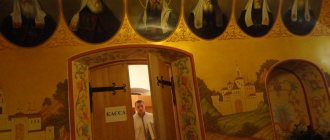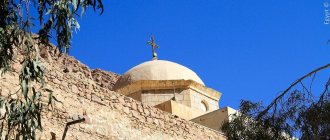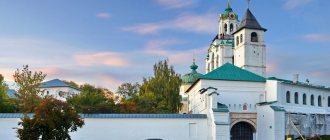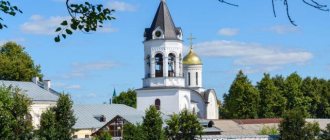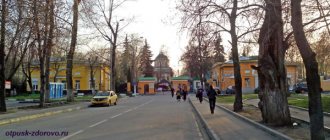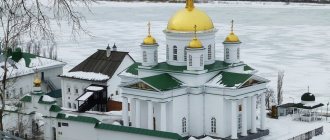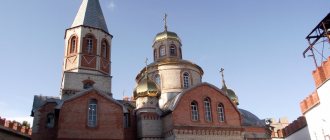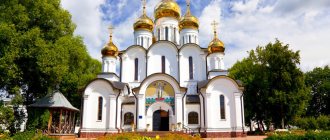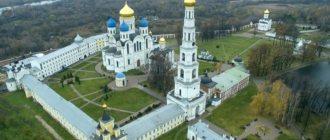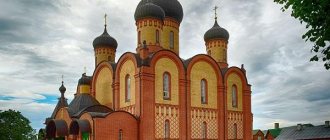| Dohiar |
Dochiar Monastery in the name of the Holy Archangels Michael and Gabriel
on Holy Mount Athos
- Address: Greece, Holy Mount Athos, Dochiar Monastery. Ιερά Μονή Δοχειαρείου, 63086, Καρυές, Άγιον Όρος, Ελλάδα
- Tel.: (30-23770)23225; fax: (30-23770)23746 [1]
- Place in the hierarchy of Athonite monasteries: 10
- Predominant nationality: Greeks
- On the map: Yandex.Map, Google map
The monastery is located in the southwestern part of the peninsula, between the Zograf and Kostamonit monasteries, on a steep hillside descending to the sea. From Dochiar to Konstamonit it is an hour and a half walk, to Xenophon 20 minutes.
| Well of the Archangels with St. water |
Story
The monastery was founded in the second half of the century by St. Euthymius, a disciple of St. Athanasius of Athos, and at the beginning was named in honor of St. Nicholas. Saint Euthymius was first a dochiar
in the Great Lavra, in charge of the storerooms, which is where the current nickname of the monastery came from.
In all likelihood, Saint Euthymius founded the small monastery of St. Nicholas near the port of Daphne. However, at the beginning of the century, under the new abbot, Venerable Neophytos, under pressure from pirates, the monks moved to a new place, where the monastery is now located. Under him, the new cathedral of the monastery was consecrated in honor of the Archangels. At that time, during the reconstruction of Dochiar, the monastery ran out of funds, and the Mother of God revealed to one young novice how to find a treasure hidden on a neighboring island. Three more monks were sent for the treasure along with the young novice, but after digging up the treasure, they became mad with greed and decided to kill the novice in order to take possession of the treasure. They hung a huge stone around the young man’s neck and threw him into the sea, but he was saved by the archangels Michael and Gabriel and instantly transferred to the monastery church. He told about what happened, the treasure was returned, and after this incident the monastery was renamed in honor of the two holy archangels. The young novice then took monastic vows and in due time became the abbot of the monastery - Venerable Barnabas.
The 14th century was a difficult period in the history of Dochiar, and by the mid-16th century only a few monks remained here. But in 1560, a priest from Adrianople named George was healed here from a serious illness by immersing himself in the spring of the holy archangels, located on the territory of the monastery, and in gratitude bequeathed his property to the monastery. Following this, significant funds came from other benefactors - the Moldavian ruler Alexander and his wife Roxandra donated especially generously to Dohiar. The water from the spring of the Archangels is still used as holy water.
| A particle of the Life-giving Cross of the Lord. Dochiar. Athos |
In 1424 there were quite difficult and difficult times on Mount Athos
In the 16th century, there were quite difficult and difficult times on Mount Athos. A gilded cross was removed from the roof of the cathedral, and the ship on which the monks were traveling had to be burned. They said that while the ship itself was burning, 2 white doves flew out of it. In the places where she landed, 2 springs opened.
One day, a priest who was suffering from paralysis found one of the miraculous springs and asked him to pour water on his hands. The monks complied with the request and poured water on his hands. Immediately the priest was healed. He decided to devote his entire life to completing the construction of the monastery.
The most majestic and beautiful cathedral temple on Mount Athos was built. Since the 18th century, quite active construction was going on in the monastery; a refectory and a chapel in honor of the Virgin Mary were built, and a bell tower was also built.
Entrance to the monastery of Dohiar monastery on Mount Athos after completion of construction
Soon Turkish troops attacked the monastery. Many shrines were stolen.
The monastery suffered quite a lot of troubles. In 1932 there was an earthquake, and in 1945 there was a large flood. This greatly affected the condition of the monastery building. Unfortunately, there were no funds for repairs at all. At that time, the monastery was in great poverty, and there were practically no people in it.
Since 1980, the Dohiar monastery began to be populated by monks again
Since 1980, the monastery began to be inhabited by monks again. The Dohiar Monastery gradually began to be restored. The monks tried to convey the original beauty of the monastery. Currently, the monastery houses many treasures of Orthodoxy - these are the relics of saints, a lot of icons, manuscripts embroidered in gold, crosses decorated with precious stones and much more.
The great shrine of the monastery is the icon of the Mother of God “Quick to Hear”. Also in the monastery there are such particles of relics as the Prophet Baptist and Baptist John, Equal-to-the-Apostles Mary Magdalene, Peter of Athos and many others.
The chronicle of the monastery says that in 1664 God glorified his Most Pure Mother in the following unusual way. In front of the image of the Most Holy Theotokos, which was painted on the wall of the monastery refectory, there was a passage along which a monk very often happened to pass with a burning torch.
In the Dokhiar Monastery the most revered image of the Blessed Virgin Mary is the Quick to Hear.
One day a monk walked past the image and heard strange words: “...Do not come here again with a lighted torch and do not smoke My image...”. One day the monk again heard vague instructions, but they were even more formidable: “...monk unworthy of this title, how long will it take you to so carelessly and shamelessly smoke my image...”.
The monk was very frightened and fell in front of the icon in prayer and tears. In the morning he was found by the brethren completely blind. Then the monks became very frightened and began to pray every day in front of this icon.
One day a monk who was blind walked past the miraculous icon of the Mother of God and heard:
“... Neil, your prayer is heard, you are forgiven. Neil, your prayer has been answered, you are forgiven. Let the brethren and all Orthodox Christians turn to me in their needs, and I will not leave anyone unheard. From now on, this image of Mine will be called “Quick to Hear,” because I will show quick mercy to everyone who flows to it with reverence...”
Even now, everyone can come to the monastery, stay overnight and pray before the holy image of the Mother of God Quick to Hear.
Dohiar Monastery -
Description.
Dochiar is an Orthodox Greek monastery on Mount Athos in Greece, the tenth in the hierarchy of Athonite monasteries. The name of the monastery (Dohiar - cellarev) comes from the fact that its founder was Abbot Euthymius, who was also the cellarer of the Lavra of St. Afanasia. “Dohiar” in Russian translation means a receptacle, or a storage room like a basement, where vital provisions are stored.
The Dochiar Monastery is located near the coast on the slope of a mountain steeply descending to the sea and is the first to greet pilgrims heading from Ouranoupolis to Holy Mount Athos. From a bird's eye view, it resembles an ancient frigate cutting through the sea waves. On the pier of the sea pier, on two majestic columns, copper figures of the Archangels - the heavenly patrons of Dohiar - greet the pilgrims as guards.
In the lower part of the courtyard of the monastery, near the western wing, there is a Cathedral Church dedicated to the Holy Archangels (Dan.10:13; Dan.10:21; Dan.12:1; Num.22:22; Joshua 5:13–15; Dan. .3:95; Dan.8:16, Dan.9:21; Luke 1:19, Luke 1:26). And at the top of the courtyard stands an ancient defensive tower that protected the monks during pirate attacks.
A tower with loopholes is erected above the main gate of the Monastery, at the base of which everyone is greeted by the fearless guards of Dochiar - the Holy Archangels Michael and Gabriel. According to the will of one of the founders of the monastery, the Monk Neophytos, he asked one of the brethren of the monastery to always celebrate the memory of the Holy Archangels with due splendor.
Initially, the monastery was located in a mountainous area, not far from the Daphnia pier and was dedicated to St. Nicholas of Myra. It was built in 967 by the ascetic St. Athanasius of Athos, the economist Euthymius. But soon this monastery was devastated by pirates and after some time the monarchy left the monastery to escape, since the Monastery was on the way of the pirates. Then the monks found a small abandoned monastery in the name of Archangel Michael and built a new monastery. The abbot was Saint Neophytos, who was from Constantinople from a large family with influence at the court of the emperor. He left his home, came to the Holy Mountain and began to build a monastery. And when he began to build the church, the funds ran out and then a great miracle happened: the archangels Michael and Gabriel appeared.
During the Latin invasion, Dochiar was captured and devastated, and the monastery farmsteads became estates of the nobles. The Latin crusades, which aimed not only to counteract Muslims, but also to destroy the Byzantine Empire and the Orthodox faith, brought many troubles to the Athonite monks. This was the most difficult time for the Holy Mountain.
In 1299, under Emperor Andronikos Palaiologos and Abbot Matthew of Dochiar, a great miracle happened: the monastery was located in an arid and infertile place and there was always a shortage of drinking water. That year there was a drought and the Archangels showed their mercy to the brothers of the monastery. That year, the monastery’s patrons, 3 km from the Monastery, found a source of clean and tasty water, but in order to deliver the water to the monastery, wooden gutters were built, and while the water reached the monastery it heated up and often spoiled, and the brethren got sick. Hegumen Matthew decided to lay a water supply system using clay pipes underground.
Today Dohiar is one of the most picturesque monasteries of the Holy Mountain. The quiet and cozy courtyard of the monastery is surrounded by the greenery of lemon and orange trees. There are pots with various flowers and bougainvillea all around. The merit of all this is due to the abbot of Dokhiar, Archimandrite Gregory. Today it is known far beyond the Holy Mountain. Pilgrims from all countries and continents come to the monastery to hear the wise words of the elder about monastic exploits, those suffering and lost in passions. At the same time, they accept the unusual blessings of the abbot with humility and joy.
The Monastery Cathedral of Dochiar is one of the highest on the Holy Mountain. In front of the entrance to the temple there is an outer nave, the floor of which is skillfully laid with pebbles, and the ceilings are made of wood and decorated with geometric patterns. The passage is painted with frescoes of the 18th century according to the models of the Macedonian school. On the northern wall there is a full-length depiction of the Archangel Michael; according to monastery legend, a Hagarene who tried to desecrate the icon fell dead at this place.
The cathedral preserves the original 16th-century paintings done by the Cretan painter Giorgi in 1568. In terms of the multitude of scenes and variety of images, the Catholicon of Dochiar surpasses all the Cathedral churches of the Holy Mountain. The skillfully carved gilded iconostasis was made in 1783.
The temple houses two miraculous icons of the Holy Archangels. One of them is in the icon case, near the column next to the iconostasis. When the fathers ordered a robe for the icon of the Holy Archangels from one jeweler, he wanted to appropriate part of the money for himself and decided to use less silver. When the jeweler began to work, his finger was glued to the robe and he could not tear it off. When he realized his mistake, he began to ask for forgiveness from the Holy Archangels. Only after this did his finger miraculously come unstuck from the robe. The jeweler returned the silver to the item he wanted to steal and, as a sign of gratitude, depicted a silver hand on the robe in memory of this event.
The second miraculous icon of the holy archangels is located in the foundry vestibule of the temple. It is called “ship” and there is a legend associated with it: the icon was on a ship on which food was brought from the monastery farmsteads. When the Turks wanted to capture the ship and take possession of it, the monks decided to burn it. From that ship, only this miraculous icon of the Holy Archangels survived.
Another ancient icon of the Archangel Michael is kept in the altar of the cathedral church of the monastery. Previously, it was located in the old marble iconostasis of the cathedral. Only once a year, on the patronal feast of the Monastery on the day of the Council of the Archangel Michael and other disembodied heavenly powers, this icon is brought out for worship by pilgrims.
At the northern wall of the casting vestibule of the monastery temple there is another ancient shrine, the Byzantine cross of the 9th century, it was used by monks in religious processions in Constantinople.
The main shrine of the Dochiar monastery is the miraculous icon of the Most Holy Theotokos “Quick to Hear”; this image is a wall fresco and was painted in 1563 on the outside of the eastern wall of the refectory. In 1664, monk Neil, fulfilling his obedience to the refectory, walked through the passage and illuminated his path with a torch and the soot fell on the Face of the Mother of God. He passed this way many times until one day he heard a voice asking: “O monk, monk, unworthy of the entire title. How long will you tarnish my image? The monk did not attach any importance to this phenomenon and another time he heard the same thing. At that moment he fell and became blind and then he realized that the voice came from the icon of the Most Holy Theotokos. They placed a small chair for him, he sat and asked forgiveness from the Mother of God for his irreverent behavior. And after a while he again heard a sweet voice coming from the icon, which announced to him: “Monk Neil, you are forgiven, sight is given to you again, inform all the brethren that I am the protection and intercession of the Monastery and let all Orthodox Christians come to me for help and from now on my icon will be called “Quick to Hear.” I will show first aid to all people with love, faith and reverence.” In 1723, in honor of the icon, famous for its many miracles, a chapel was built on this site. On October 1, the Day of the Most Holy Theotokos is celebrated in honor of her icon “Quick to Hear.”
In the Cathedral Church of the monastery, the monks carefully preserve the relics of many saints: part of the Tree of the Holy Cross, donated in 1560 by the monastery’s patron, governor Alexander Lapusneanu, ruler of Moldo Wallachia. The relics of Saints Tryphon, Harlampius, Hermogenes, Artemios and Paraskeva are kept in the ark. The ark contains the honorable head of Dionysius the Areopagite, who was the first bishop of Athens. Another reliquary contains part of the head of the Baptist John the Baptist and Two Particles of Saints Charlampius and Tryphon; another reliquary contains part of the fabric with the blood of the Great Martyr Demetrius of Thessalonica, the Martyr Theodore of Byzantium, and also contains part of the hand of the right hand of Saint Marina and the palm of Saint Paraskeva. The altar of the Cathedral Church of the monastery houses the shroud, which is used as an antimension during divine liturgies. Every year the monks of Dochiar make a procession with the shroud around the monastery.
The monastery tower houses a library containing 620 ancient manuscripts and more than 5,000 early printed books. The 12th century Four Gospels from Nicaea are kept here. This manuscript contains miniatures of many saints and is decorated with rich ornaments. Bright colors have a special composition, thanks to which they do not fade during long-term storage. Moldavian manuscripts and charters are also kept here, most of them written in Old Church Slavonic. The ancient Gospel of the 18th century, brought to the Dohiar monastery from Moldova, is kept.
History of creation.
In the 14th century, the monastery, which was then going through difficult times, received help from the Byzantine Emperor John V Palaiologos and King Stephen IV of Serbia. At this time, Dochiar acquired the possession of the neighboring small deserted monasteries of Nevrakopou, Koligraf and Skamandrin. But, with the beginning of Turkish rule on Mount Athos, Dokhiar became depopulated and was in decline for 100 years.
In the 16th century, priest George came to the monastery from Adrianople; he lost his family due to an epidemic, and the disease left him with paralysis of his arms and severe headaches. He came to the Dohiar monastery to the holy spring and asked the monks to pour Holy water on his hands. He felt his hands come to life. After this, he poured Holy water on his head and felt that he was healed. Struck by the miracle, he decided to stay in the monastery and devote his life to God. He donated all his property to the monastery, took monastic vows with the name German and then went to Moldova to raise funds for the restoration of the monastery. The ruling ruler at that time, Petru Rares, having heard about many miracles of the Holy Archangels, allocated funds for the restoration of the monastery. Later, when Alexander Lapusneanu was the ruler of Moldavia, the construction of a new Catholicon of the monastery began. Moldova helped the monastery a lot during difficult years. When in 1546 there was a great earthquake on the Holy Mountain and the church was destroyed, architects came from Moldova and gave money to restore the monastery. On behalf of the ruler of Moldova, Alexander Lapusneanu, the restoration of the monastery was supervised by Bishop Theophan of Moldova, who left his witnessing chair and arrived at the Dochiar monastery, where he lived until the end of his days and was buried in the vestibule of the restored church of the monastery.
During these difficult years, Sultan Selim III confiscated all monastic possessions and the Monastery was on the verge of ruin. The monks again turned to the rulers of Moldova for help. The rulers gave money and they were able to regain their possessions. Roxandra, the ruler of Moldavia, gave money to buy out land, farmsteads, mills, estates and possessions.
In the main cathedral of the Monastery, an inscription has been preserved that reads: “This Divine temple was erected from the foundation and painted by the support of the most faithful lord, John Alexander, governor of all Moldova under Abbot Theophilus in 1568.” And on the southern wall of the foundry vestibule of the temple there are frescoes depicting the ktitors of the Dochiar monastery of the Moldavian ruler Alexander Lapusneanu, his wife Roxandra and their son Bogdan. Since then, every year on the Day of Remembrance of St. Nicholas, the monks perform all-night vigils and a memorial service for the repose of their souls. This tradition is strictly observed to this day.
At the beginning of the 17th century, under the leadership of Abbot Seraphim, active construction work was carried out in the monastery, the number of monks increased and reached 100 people. And two new Compounds in Malachi, the Slobozia Monastery and the Apostolake Monastery with large land plots, significantly eased the difficult financial situation of the Monastery.
But new trials awaited the monastery. In 1664, Dohiar began to ask the Turks for a reduction in taxes; in response, they attacked the monastery and the inhabitants were forced to leave it. On the marble jamb of the southern door of the Cathedral there is an inscription: “October 5, 1664 the Turks came and we left.”
In the 18th century, the monastery continued to be rebuilt. During this period, part of the refectory, a chapel in honor of the miraculous icon of the Mother of God “Quick to Hear,” the northern wing of the monastery, and a bell tower were erected.
In 1821, during the Greek national liberation uprising, the Turks plundered the monastery, destroying almost all of its relics. The only thing they left was the walls. Of the 150 monks living in the monastery before the uprising, only 38 remained.
A document dated 1822 talks about two monks who took silver candlesticks and reliquaries and took them to Thessaloniki. There they were melted down to pay taxes to the Turks. At the same time, the precious robe that adorned the miraculous image of the Most Holy Theotokos disappeared.
In 1831, the Turks left Athos suddenly, without war or bloodshed. Then everyone accepted it as a miracle of the Most Holy Theotokos. After the withdrawal of Turkish troops, the restoration of the monastery began. New chandeliers, candlesticks, crosses, Holy Cups and Gospels appeared in the monastery. During this period, many new buildings were built around the monastery, on the Athos plots and farmsteads. All this was built thanks to donations from pilgrims and income from the Slobozia metochion in Wallachia, which was led by Archimandrite Gabriel. This Compound at that time became the main source of income for the monastery.
In the second half of the 19th century, a period of gradual deprivation of Dohiar began. In 1860, the ruler of Romania, Alexander Cuza, expelled all the Holy Mountain residents from the state and said that Romania is only for Romanians and everyone else should leave. Thus, a large courtyard was lost. When leaving, the fathers took away a large archive with property documents. These documents are still kept in the monastery.
After the annexation to Bulgaria, Eastern Romania Dohiar lost its possessions in this region. The Balkan Wars, the First World War, and the Greco-Turkish War deprived the monastery of farmsteads in Eastern Thrace, Asia Minor, and the Greek lands. This complicated the already difficult situation of the monastery, and the terrible earthquake in the city and Iereson in 1932 and the great flood of 1945 adversely affected the condition of the monastery building. Despite all the difficulties, the monastery had enough strength and means to carry out only superficial repairs. By the end of the seventies of the 20th century, the elders, on whose shoulders the monastery rested for almost 75 years, passed away. Dokhiar was poor and almost depopulated. The revival of the monastery began in April 1980 with the arrival of the brethren of the Prusu monastery, headed by abbot Archimandrite Gregory. He convinced the authorities of the good intentions of the brethren and guaranteed respect for the fathers and the established order. In the same year he was elected abbot of Dohiar. At the same time, restoration of the rather dilapidated monastery began. The roofs of the refectory, the chapels of the icon of the Mother of God “Quick to Hear” and in the name of the 40 Martyrs of Sebaste, as well as the southern wing of the monastery, were replaced, the frescoes in the refectory were restored, the bell tower, the gate tower and many other buildings of the monastery were repaired. The fields were cultivated by the hands of monks and pious pilgrims, the olive garden of the monastery was revived, and the number of monks of the monastery brethren increased significantly.
Author of the text: Anastasia Kanishcheva.
On Mount Athos, monks go to the temple - like a modern person living in the world, to the cinema, with joy
— What is distinctive about Athonite services? They say that this is something special, as if you are ascending to Heaven.
— The service is perceived very naturally, there is no feeling of tension or artificiality. On Mount Athos, monks go to the temple - like a modern person living in the world, to the cinema, with joy. This creates a calm atmosphere at work, everyone knows why they are here, this is their home. And on Holy Mount Athos there is a big difference between holidays and weekdays, which creates a certain rhythm: holiday services are one thing, Sunday services are another, daily services are another. Everything taken together: peaceful praying monks, architecture and decoration of temples, icon painting, Byzantine singing - all this creates an unforgettable sensation and experience.
There is such a chapter of the Typikon - “On Lamps”, which regulates the lighting of lamps and candles in the temple at certain moments of the Divine Service. During our years of studying in theological schools, we all wondered why anyone today needs to know when to light and when to extinguish candles during a service. This is what most modern church people think. They lit the chandelier, turned on the electricity, that’s all. And the lamps, they say, are lit only to make a sacrifice to God.
And so on Mount Athos, where electricity is not used during Divine services, an understanding came: “to light” and “to put out” turned out to be real music. And all this music begins to sound when the service takes place at three in the morning. You come to the temple - several lamps are burning, then another lamp is lit, then another is lit, then a candle is lit... This is a whole poetry expressed in lamps. As an example, a lamp in front of the icon of the Savior - we not only make a sacrifice to the Savior, but the light from the lamp illuminates the face of the Savior so that we can see Him. When we turn on the electric light, what does the lamp illuminate? Nothing.
—Are there flowers in the temples on Athos?
— Each monastery has its own traditions. Dohiara has many traditions from the island of Patmos. For every major holiday, the floor is covered with various greenery. For example, on Palm Sunday the temple will be hung with crosses made of palm branches, and on Easter the floor will be covered with lavender. On other holidays - leaves of citrus trees. Icons can also be decorated with flowers. This is why there is such an amazing aroma in the temple...
